Do you have a question about the Miele KFN 12823 SD-1 and is the answer not in the manual?
Details the buttons, displays, and indicators on the appliance control panel.
Illustrates and labels the various internal parts and compartments of the refrigerator-freezer.
Instructions on environmentally friendly disposal of packaging materials, including safety for children.
Guidance on how to properly dispose of the old appliance, emphasizing environmental and safety aspects.
Defines the intended use of the appliance and specifies applications that are not supported or may be dangerous.
Provides specific safety guidelines for children interacting with or using the appliance.
Covers electrical safety, coolant hazards, installation safety, and connection requirements to prevent damage or injury.
Details crucial usage instructions to prevent hazards like frostbite, explosion, or damage from improper food storage.
Provides tips on installation site, temperature settings, and usage habits to reduce energy usage.
Guides on removing protective foil, cleaning, and the procedure for the first-time power-up.
Explains how to switch off the appliance completely, the refrigerator section separately, or for extended periods.
Specifies optimal temperatures for the refrigerator and freezer sections for effective food preservation.
Details how to use the temperature buttons to set desired temperatures for each section.
Explains the meaning of temperature indicators, flashing lights, and the adjustable temperature ranges.
Describes the warning system for temperature deviations and open doors, including causes and indicators.
Provides instructions on how to temporarily switch off audible alarms if they become disruptive.
Explains how to use the Super Freeze feature for rapid freezing and when it is not necessary.
Details the Dynamic Cooling function for even temperature distribution and its activation conditions.
Explains how different temperature zones within the refrigerator affect food storage.
Covers what foods not to refrigerate, shopping tips, general storage, and specific advice for fruits, vegetables, and meats.
Instructions on how to move shelves and configure the split shelf for different storage needs.
Guidance on repositioning the door shelves or bottle racks to accommodate various items.
Information on maximum freezing capacity and the importance of freezing fresh food quickly.
Advice on checking packaging, dates, and shop storage conditions for purchased frozen items.
Covers suitable foods, unsuitable foods, blanching, packing, and placing food in the freezer for optimal results.
Lists various methods for defrosting frozen food, including hygiene precautions for poultry and meat.
Instructions for making ice cubes and safely cooling drinks in the freezer.
Explains how the automatic defrost system works for both the refrigerator and the "Frost free" freezer section.
Details what cleaning agents to avoid and steps to take before cleaning the appliance.
Provides instructions for cleaning the appliance's interior, accessories, doors, and side panels.
Steps to diagnose and resolve issues where the appliance is not cooling adequately.
Addresses problems like temperatures being too low, compressor switching too often, or food thawing.
Covers issues such as food freezing together, door opening problems, alarms, and interior lighting failures.
Describes common noises like humming, gurgling, and clicking, explaining their causes.
Offers solutions for easily rectifiable noises such as uneven appliance placement or unstable items.
Provides contact information for dealers and Miele support for service and guarantee inquiries.
Details how to activate the appliance guarantee and where to find country-specific information.
Outlines safety regulations and procedures for connecting the appliance in the UK, including plug types.
Specifies requirements for non-rewireable plugs, fuse replacement, and earthing for safe operation.
Advises on selecting a suitable installation location considering ventilation, sunlight, and ambient temperature.
Explains the appliance's climate range compatibility and the importance of adequate ventilation at the back.
Provides the physical dimensions of the appliance and guidance for integrating it into kitchen units.
Step-by-step instructions for safely removing and reattaching the door handles during hinging.
Detailed procedure for removing and re-fitting both the upper and lower appliance doors for hinging.
Guides on how to align the appliance doors correctly after changing the hinges for proper sealing.
Instructions for installing the appliance within kitchen furniture, including ventilation gaps and clearances.
Details the buttons, displays, and indicators on the appliance control panel.
Illustrates and labels the various internal parts and compartments of the refrigerator-freezer.
Instructions on environmentally friendly disposal of packaging materials, including safety for children.
Guidance on how to properly dispose of the old appliance, emphasizing environmental and safety aspects.
Defines the intended use of the appliance and specifies applications that are not supported or may be dangerous.
Provides specific safety guidelines for children interacting with or using the appliance.
Covers electrical safety, coolant hazards, installation safety, and connection requirements to prevent damage or injury.
Details crucial usage instructions to prevent hazards like frostbite, explosion, or damage from improper food storage.
Provides tips on installation site, temperature settings, and usage habits to reduce energy usage.
Guides on removing protective foil, cleaning, and the procedure for the first-time power-up.
Explains how to switch off the appliance completely, the refrigerator section separately, or for extended periods.
Specifies optimal temperatures for the refrigerator and freezer sections for effective food preservation.
Details how to use the temperature buttons to set desired temperatures for each section.
Explains the meaning of temperature indicators, flashing lights, and the adjustable temperature ranges.
Describes the warning system for temperature deviations and open doors, including causes and indicators.
Provides instructions on how to temporarily switch off audible alarms if they become disruptive.
Explains how to use the Super Freeze feature for rapid freezing and when it is not necessary.
Details the Dynamic Cooling function for even temperature distribution and its activation conditions.
Explains how different temperature zones within the refrigerator affect food storage.
Covers what foods not to refrigerate, shopping tips, general storage, and specific advice for fruits, vegetables, and meats.
Instructions on how to move shelves and configure the split shelf for different storage needs.
Guidance on repositioning the door shelves or bottle racks to accommodate various items.
Information on maximum freezing capacity and the importance of freezing fresh food quickly.
Advice on checking packaging, dates, and shop storage conditions for purchased frozen items.
Covers suitable foods, unsuitable foods, blanching, packing, and placing food in the freezer for optimal results.
Lists various methods for defrosting frozen food, including hygiene precautions for poultry and meat.
Instructions for making ice cubes and safely cooling drinks in the freezer.
Explains how the automatic defrost system works for both the refrigerator and the "Frost free" freezer section.
Details what cleaning agents to avoid and steps to take before cleaning the appliance.
Provides instructions for cleaning the appliance's interior, accessories, doors, and side panels.
Steps to diagnose and resolve issues where the appliance is not cooling adequately.
Addresses problems like temperatures being too low, compressor switching too often, or food thawing.
Covers issues such as food freezing together, door opening problems, alarms, and interior lighting failures.
Describes common noises like humming, gurgling, and clicking, explaining their causes.
Offers solutions for easily rectifiable noises such as uneven appliance placement or unstable items.
Provides contact information for dealers and Miele support for service and guarantee inquiries.
Details how to activate the appliance guarantee and where to find country-specific information.
Outlines safety regulations and procedures for connecting the appliance in the UK, including plug types.
Specifies requirements for non-rewireable plugs, fuse replacement, and earthing for safe operation.
Advises on selecting a suitable installation location considering ventilation, sunlight, and ambient temperature.
Explains the appliance's climate range compatibility and the importance of adequate ventilation at the back.
Provides the physical dimensions of the appliance and guidance for integrating it into kitchen units.
Step-by-step instructions for safely removing and reattaching the door handles during hinging.
Detailed procedure for removing and re-fitting both the upper and lower appliance doors for hinging.
Guides on how to align the appliance doors correctly after changing the hinges for proper sealing.
Instructions for installing the appliance within kitchen furniture, including ventilation gaps and clearances.
| Brand | Miele |
|---|---|
| Model | KFN 12823 SD-1 |
| Category | Refrigerator |
| Language | English |
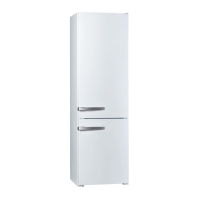
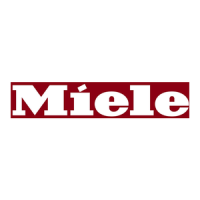

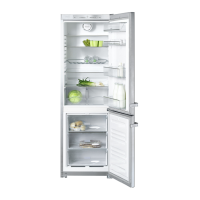




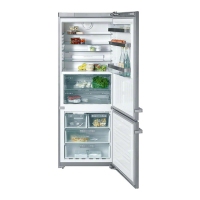
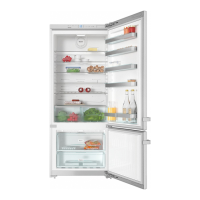
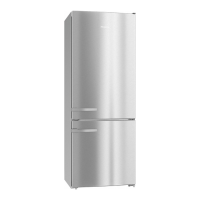

